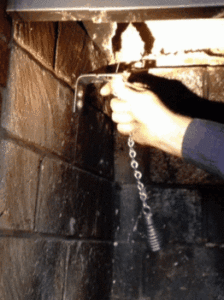 Most homeowners know what their damper is and how to use it, but may not understand how it is important to the overall safety and efficiency of the chimney and fireplace.
Most homeowners know what their damper is and how to use it, but may not understand how it is important to the overall safety and efficiency of the chimney and fireplace.
What is a fireplace damper?
A fireplace damper is a piece of metal that acts as a barrier between the firebox and the rest of the chimney. Located at the top of the firebox, dampers are opened and closed when the fireplace is in use to prevent smoke, gas, and other byproducts of combustion from blowing back into the home. Dampers are also used to help keep moisture, animals, and unconditioned air out of the firebox and home.
Two types of dampers
There are two types of dampers that can be used in your home.
- Throat damper: Throat dampers have been used for years and are found in the majority of homes. Sitting at the top of the firebox, throat dampers close off the firebox from the rest of the chimney, while the top of the chimney is open to outside air and protected by a chimney cap.
- Top sealing damper: Top sealing dampers are one of the most recent innovations in the chimney industry and are beginning to be used in more and more homes. Top sealing dampers are located at the top of the flue where the chimney cap traditionally sits. Top sealing dampers are still opened and closed using levers or pulleys when the fireplace is or is not in use. When closed, the top sealing dampers closes off the entire chimney system from outside air. This can help reduce heating and cooling costs as unconditioned air in the chimney is not affecting air temperature within the home.
Signs of damper damage
Whether it’s from years of use or overexposure to heat or the elements, dampers can become damaged and need to be repaired or replaced. The following are three signs that your damper may be damaged.
- Broken pulley or lever: Pulleys and levers are used so that the damper can be opened and closed when the fireplace is in use. If this mechanism breaks, the damper can become stuck in one position. This can impact the safety and efficiency of your fireplace system – and even prevent you from using your fireplace altogether.
- Loss of airtight seal: If you can feel or hear air coming through the damper when it is closed, your damper has most likely lost its airtight seal. This can happen after years of exposure to heat or if the damper has been forcibly opened or closed.
- Rust: Rust on the damper indicates that there has been a chimney leak. If the leak has already been repaired, the damper can be replaced before the rusting metal deteriorates further. If the leak is new, its source should be identified and repaired before you repair the damper; this keeps future damper damage from occurring.
The damper is an important part of your fireplace system; it protects your home from exposure to outside air while helping the fireplace to vent safely and efficiently. For more information on fireplace dampers or to schedule an inspection to check on the condition of your damper, contact Pristine Sweeps today!
